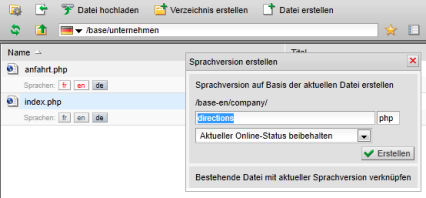Enhanced language management
With Weblication® CMS, you can manage websites in any number of languages. Each language can have differently named pages and directories within the same structural depth.
In the case of a multilingual presence, the different languages (e.g. German, English, French) can be organized using the "Advanced language management" module. Various functions and settings can be used to simplify the editing process for the different languages and define an automatic process in certain areas.
The extended language management allows you to freely name the file and directory structure within the same structure depth based on the respective language directory. The pages that belong together can be conveniently linked via the file explorer.
Example:
- /en/company/directions.php
- /en/company/directions.php
- /fr/entreprise/ledirections.php
Edit language links
Corresponding pages are recognized by language management by default and linked automatically. If you want individual directory and/or file names in the respective language versions, you can define this via the language link in the directory view. Please note the information on the default language at the bottom!
Based on the (default) language, you can create non-existent language versions via an edit mask. The directory view shows you the corresponding language abbreviation as a button for the files and directories for each existing language. Pages that do not yet exist in other language versions are displayed in red for the language abbreviation. The language version of the current directory is indicated by a button in darker gray (in the example screen below the language "de").
To create a page in a different language based on the current language version, click on the red language abbreviation of the corresponding language.
This is demonstrated in the example using the file /base/unternehmen/anfahrt.php. Clicking on the red en language abbreviation (button) opens the "Create language version" screen:

To create a language version based on the current file, select the first selection. A screen for entering the file name opens. Enter the desired file name here (e.g. direction). The file extension is already predefined based on the original language.

To link an existing file with the current language, select the second selection. A screen for selecting the language link opens. Select the desired file that is offered to you in the selection field from the already linked language directory and then click on the"Link" button.

Release language link
To delete an existing language link, open the directory of the corresponding file and click on the language abbreviation of the current language.
In the example, delete the /base-en/company/direction.php file from the link by clicking on the en language abbreviation in the /base-en/company/ directory for the direction.php file. In the selection, click on the "![]() Delete current language version from the language link" button to delete it.
Delete current language version from the language link" button to delete it.

Please note
You can also create new directories in the other language in the same way as for files. The mask differs only in the name (e.g. "Create language version based on current directory") and the input field, which allows you to enter the directory name. When creating directories, you also have the option of creating them with content or as an empty directory.
If there is no assigned language directory in the other language, no language files can be linked!
For multilingual presences, define a default language from which the language links are to be made! This means that language links can only be edited and resolved using the defined language, which ensures consistent language node management!
You can define the default language project (default language) in the project settings of the language project.


